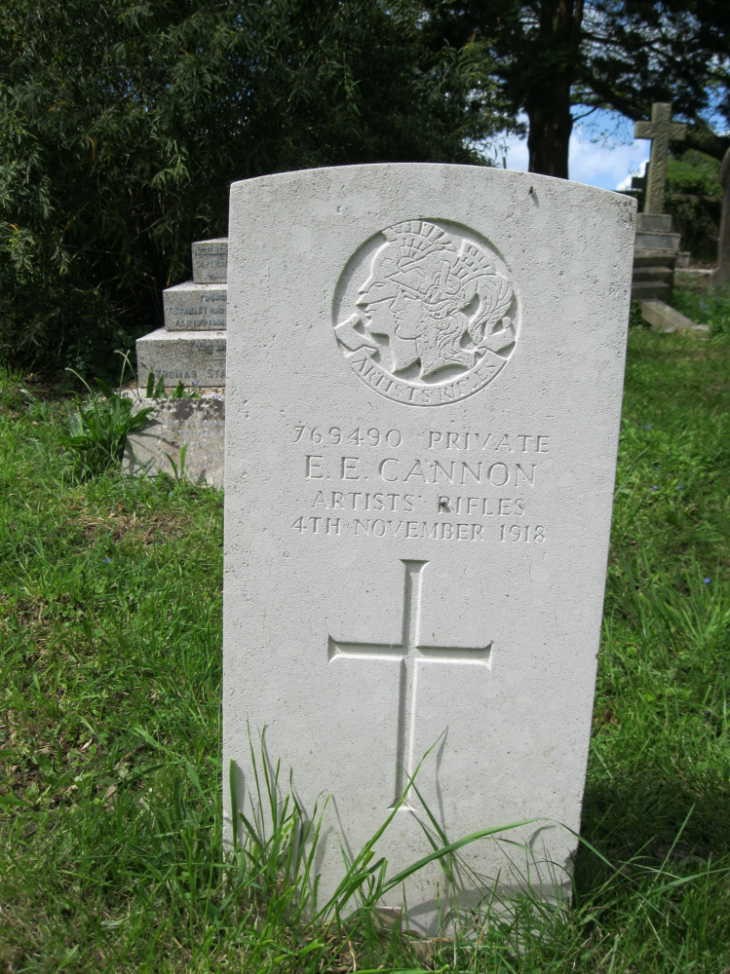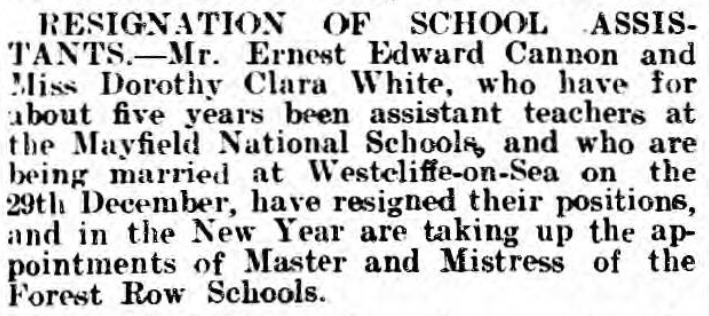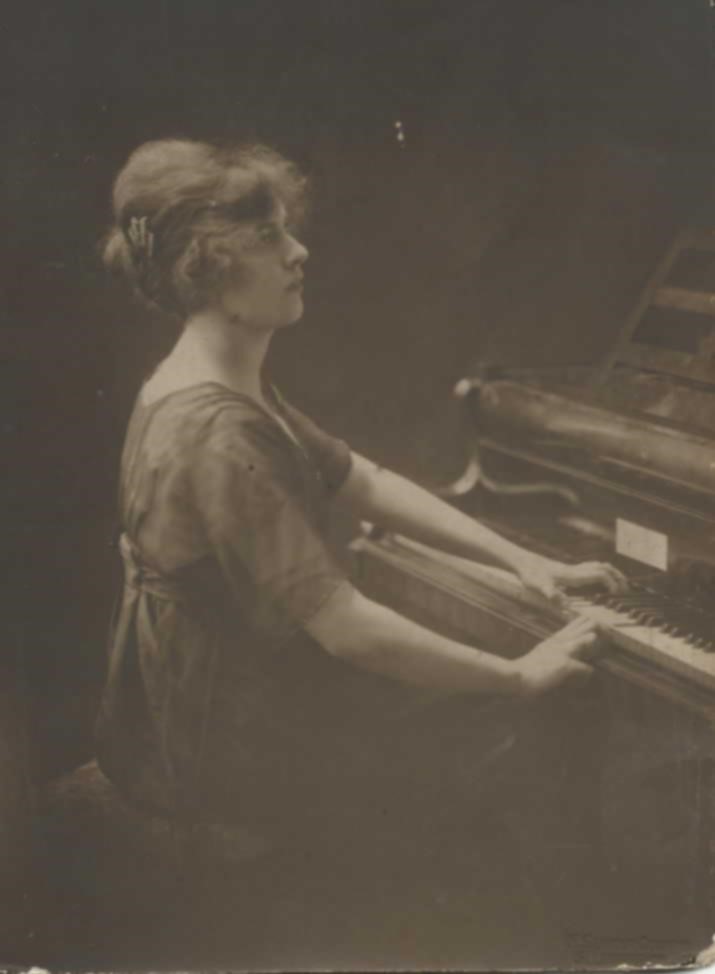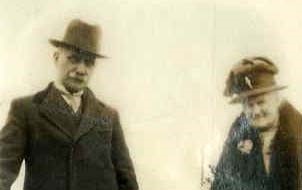ERNEST EDWARD CANNON
Private, 769490, 28th London Regiment, The Artists' Rifles
Died from influenza, Military Hospital, Warley, Essex, 4 November 1918, aged 28
Buried in Forest Row Cemetery, Grave 934

The grave of Ernest Edward Cannon in Forest Row Cemetery
(Click to enlarge)
Despite giving his place of birth as Leatherhead on the 1911 census, Ernest Edward Cannon was actually born in Penshurst, Kent, though the family moved to Leatherhead when he was very young. He was the third child of Thomas Cannon and Fanny (née Horton) who had married in Bidborough in 1887. Ernest's older siblings were twins Frederick and Rosalie, also born in Penshurst. In 1891 the family was recorded at Kingston Road, Leatherhead, and Thomas was working as foreman in a coal yard. Ten years later they were living at Market Terrace in Hastings, and Thomas was now a dairy manager, probably a step up. A daughter Dorothy had joined the family.
Ernest was obviously a bright boy, as was his brother. The Hastings and St Leonards Observer reported that at a Children's Exhibition in 1900, Frederick had won first prize for Maths and Ernest third prize. Ernest also gained a first for Grasses. In 1898, he was given a prize by the Parochial School for Good Conduct and Progress. In 1902 the paper noted that, at the St Leonards Sunday School prize distribution, Ernest had not only 'gained all possible marks' but had also won a medal for unbroken and punctual attendance. He repeated his Sunday School 'full marks' score the following year. In 1904, at the St Leonard's Parochial School, Ernest shared the Standard VII medal with another boy, but the Headmaster also awarded him the prize for general intelligence. In the same year he was presented with 2/- from the Diamond Jubilee Prize Fund by the Archdeacon of Lewes for his knowledge of scripture. By 1906 he was at the Municipal School of Science and Art in Hastings, and, according to the Observer, still winning accolades, this time for a pass in a Physiography exam. In fact, it seems the Hastings and St Leonards Observer was for ever printing his name.
In 1911 the family was still at Market Terrace, and Thomas was still a dairy manager. However, he has written 'at home' in the column of the census return specifying where work was carried on, so presumably he was 'living over the shop' so to speak. His family were doing well for themselves: Frederick was a jeweller and watch repairer; Rosalie was a clerk to a gasfitter and electrician; and Ernest was, at 20, already a teacher at a National School run by the Borough Council.
No record of Ernest's training has been found, but he entered the teaching profession as times were changing with regard to teacher training:
In 1906 King's Scholarships were abolished. From 1907 there was a 'Preliminary Examination for the Elementary School Teachers' Certificate' which was in two parts — Part I had to be passed, and only those who passed it could take Part II.
All of Part I was compulsory, in Part II, English, History and Geography were compulsory and then candidates would sit 3 or more options from 3 groups — Elementary Maths, Elementary Science and Foreign Languages.
In April 1907 Morant went much further in dismantling the existing system when he issued Regulations 'for the Preliminary Education of Elementary School Teachers'. This introduced an alternative to the traditional method of Pupil-Teacher training. From Aug 1907 selected pupils at Secondary Schools could be awarded 'Bursaries' — grants to enable them to stay an additional year at school between 16 and 18. On completing this year they could either enter training college straight away, or could serve in schools as 'Student Teachers' for up to one year and then enter college.
From Aug 1909 Board of Education would only recognise applicants who had been pupils at recognised Secondary schools for at least the 3 previous years and would only pay a grant to Bursars who passed (either during their Bursary year or within one year after) one of the exams qualifying them for entry to training college. Bursars could be accepted at training college at 17, a year earlier than pupil-teachers.
Although we don't know which route he took, on 17 December 1915, the following appeared in the Sussex Agricultural Express:

(Click to enlarge)
The couple took over Forest Row School in January 1916 and, according to Byford, created a new beginning for the pupils. As a teacher, even under the draft of 1916, Ernest was not required to join up, but by the end of the war, even clergymen were being considered as suitable conscripts. According to the Register of Soldiers' Effects, he did not finally join the army until 11 October 1918, which meant that there was no war gratuity payable to his widow.
This document also states that he died at the Military Hospital, Warley, which is in Essex.

(Click to enlarge)
However, a biography posted on Find a grave places his death at Maubeuge as a result of the battle for the Sambre Canal. I suspect the latter suggestion may stem from a misreading of the Artists' Rifles' Roll of Honour. The entry above Cannon's does give Maubeuge as the place of death, but against Ernest's name it simply says 'Died'. Again, it is Byford who clarifies matters. Ernest contracted influenza — probably before he had even finished training — and died just a week before the Armistice.
(Click to enlarge)
The Artists' Rifles was popular with volunteers, especially those who were well educated, as Ernest must have been. War poet Wilfred Owen, who also died at the very end of hostilities, was part of this regiment for a while. Cannon clearly came from an artistic family. His brother, as has been said, was a jeweller, and his sister Dorothy was a singer and pianist, giving concerts in Hastings as well as teaching music to her own pupils.

Dorothy Cannon
(Click to enlarge)
Ernest's mother died at St. Leonards in 1937, but Thomas lived on until 1950. Presumably they are buried in Hastings somewhere, but his widow, who was living in Westcliff-on-Sea in Essex by the time she submitted her husband's details for the Forest Row Memorial Book, presumably chose to have him buried at Forest Row, where he had been headmaster.

Thomas and Fanny Cannon in later life
(Click to enlarge)
Ernest's wife Dorothy never remarried. She evidently settled in Essex, and died there in 1948. Her sister-in-law Dorothy was also living in Essex at the time, with her husband Rev. Frederick Stroud.
Pam Griffiths
17 August 2018

